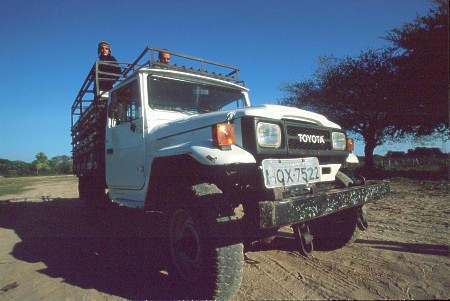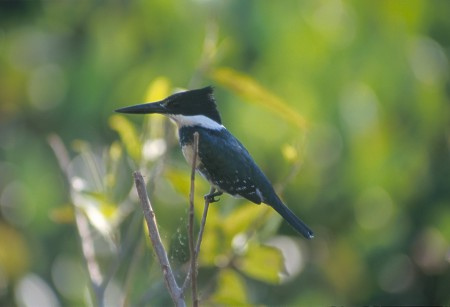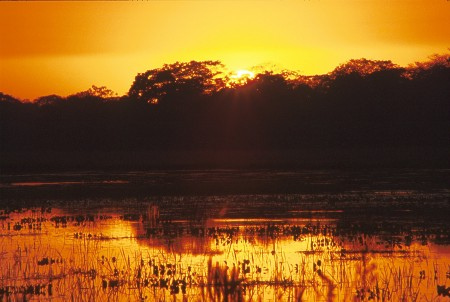Coxim & Rio Verde
The Nhecolândia region covers the area between the Taquari river and the Rio Negro. The temperature ranges from 20°C in winter, reaching 41°C in summer. The two main towns are Coxim and Rio Verde de Mato Grosso, which are located just outside the Pantanal in an area which is predominantly cerrado savannah and woodlands. The cerrado is recognised for its high bio-diversity and is Brazil's second-largest ecosystem, originally covering an area exceeding two million km², and spread across four states in central Brazil.
Coxim
Coxim is a popular location for fishing, and is located at the confluence of the Coxim and Taquari rivers. The town is also surrounded by several other rivers, resulting in it to be known locally as the "Paradise of Waters". Within these rivers, anglers can find pintado catfish, jaú, dourado and piraputanga.
History
The territory in and around Coxim was originally populated by the Kayapó indians, also called the "Coroado" (crowned) indians because of their impressive headdresses. Kayapó tribes once ranged over a vast region across Mato Grosso and Mato Grosso do Sul, but slave raids conducted by bandeirantes and introduced diseases proved disastrous for them - causing the survivors to flee and retreat towards more remote territories. Although no longer present in the territory around Coxim, the Kayapo remain a famous tribe in modern Brazil through their involvement in the Xingú Reserve in Northern Mato Grosso. Other tribes in the area included the Bororó and Guaicurú.
European settlement in the region followed after the discovery of gold in Cuiabá in 1719. Although the bandeirantes had traditionally trekked overland from São Paulo, this proved impractical for the large number of miners, merchants and administrators now arriving with their goods and baggage trains. The alternative involved journeying across the country in canoes along a network of rivers, portaging over rapids or between adjacent river basins. These journeys known as Monções (Monsoons) were the main highway into the Mato Grosso territory through the 18th and 19th centuries until the advent of steamships and the railroad. Coxim and nearby Camapuã (site of the 14km overland trek between the Rio Pardo and Rio Coxim) were significant stops on this journey. There are few remnants of this today, but the Pedra do Letreiro - which is a rock carrying inscriptions made by the captains of each journey, is thought to have served as an expedition register or maybe just as a way for passengers to have left a reminder of their own passage through.
The town of Coxim started as the village of Belliago, founded in 1729 on the opposite side of the river where Coxim is located today. The founders were Manuel Caetano, priests Antônio de Moraes and José de Frias, Domingos Gomes Belliago, and the Lemes brothers who had been awarded the grant for the region. This village served as a supply port for the river expeditions, but didn't develop much beyond that until the mid-19th century when it was elevated to the status of a Parish. A military post was established in 1862, with the settlement being renamed as Taquari. This town was captured by Paraguayan forces during the Paraguayan War and was largely destroyed. The post was rebuilt during the post-war period, being formally recognised as a town in 1898. It has gone through several name changes being variously called Belliago, Taquari, Herculânia, and eventually Coxim.
Economy
The local economy is based on agriculture such as cattle ranching and soya plantations. Although they have high importance for biodiversity, the surrounding cerrado grasslands were once considered wasteland and naturally infertile for agriculture. However, Brazilian researchers discovered that this could be resolved through the addition of appropriate quantities of lime and phosphorous - leading to significant agricultural expansion. Brazil is now the world's second largest producer of Soy, and one of the world's top beef producers. However this has come at some environment cost with degradation of rivers, and reduced natural areas including the cerrado.
Eco-tourism is a significant contributor to the local economy, with the area being highly popular with Brazil's sports fishermen. The protection of this industry is a strong incentive for ongoing environmental management and preservation.
Things to See and Do
Casa do Artesão (Museu Arqueológico)
Rua João Pessoa, 210.
Open 8-11am and 1-5pm weekdays.
This offers products similar to the other equivalent boutiques in other towns - with works in bamboo wood, clay and fabrics. This is also adjoins a small archaeologic museum displaying fossils, indigenous artefacts, and items from the town's pioneer days.
Piracema (Spawning Period)
The period Aug-Oct brings one of the best natural spectacles in the Pantanal. This is when schools of fish can be seen swimming upriver and jumping up small rapids and waterfalls such as Cachoeira das Palmeiras. Jacaré have been known to position themselves mid-stream above the rapids with their mouths open - just waiting for hapless fish to jump in.
Pedra do Letreiro
These can be found on the banks Cênico river, but will need to be found travelling by motorboat using a local guide. They're located on rock formations near the Cachoeira do Letreiro. The inscriptions were made by travellers journeying along the rivers from São Paulo to Cuiabá during the Monções.
Rio Correntes
This can be found north of Coxim, close to the town of Sonora, and is the divisor between Mato Grosso and Mato Grosso do Sul. This is reputed as one of the best in the region for fishing. There's also curious spot where the river flows down into a sinkhole (sumidouro) for approximately 400m.
Places to Eat
Restaurants in the town are aimed at fishing tourists, and located along the riverfront. Their specialty is, appropriately enough, fish.
Name
Description
Restaurante Vo Pedro
BR 163, Travessa Taquari, Coxim
Popular riverside restaurant specialising in fish.
Cabana do Osmar
Avenida Coronel Pedro Severo, 37
Popular riverside restaurant run by Osmar, a well-known local fishing guide.
Places to Stay
The only hotels or pousadas in and around Coxim are fairly basic, and geared primarily for families and fishing tours. Even if not fancy, they're pleasant enough for a short stay.
Name
Description
Hotel Coxim
4km from Coxim, at km 726 on BR-163
cachoeiradaspalmeiras.com.br
This is the best option close to town. Not overly flash but popular with fishing tours and families.
Hotel Santa Ana
Rua Miranda Reis 222, Coxim
This is a fairly basic hotel. It's not fancy, but it's clean and reputable.
Pousada Cachoeira das Palmeiras
22km from Coxim, at km 683 on BR-163
cachoeiradaspalmeiras.com.br
Small pousada near the Cachoeira das Palmeiras waterfall. Good spot for fishing or to relax, with a great view of fish jumping upstream during Piracema. Sometimes runs boat trips and photographic tours.
Fazenda Amaralina
19km from Coxim, on Estrada do Pantanal
Facebook page
Located in the Vale do Salto. Popular spot for catch and release fishing of pacu (vegetarian cousin of the piranha), horse riding, and nature treks to the 35m Cachoeira do Salto waterfall and clear water streams.
Getting There and Away
Bus: Andorinha, Motta, and Nova Integração bus companies operate several buses per day between Campo Grande and Coxim. The journey takes 4.5 hours, with prices range R$ 48-75 depending on the type of bus.
Road: Coxim is located 255km north of Campo Grande, and 53km from Rio Verde de Mato Grosso, on BR-163. From Coxim its a further 225km north to Rondonópolis.
Rio Verde de Mato Grosso
Rio Verde is located 52km south of Coxim along BR-163. It shares a similar history - also having been originally peopled by the Kayapó - although the town is located some distance away from the paths followed by the Monções. European settlement began in the period following the Paraguayan War, in 1885 when Américo de Souza Brito purchased a strip of land along the Rio Verde. Brito intended using the land for livestock, although he ended up reselling most of the land to migrants and other new settlers. This led to the creation of new farms and agriculture - and formed the nucleus of a community that later became Rio Verde. With further development and an influx of miners following the discovery of gold, the town was elevated in status to a district in 1931, also going through several name changes to Herculânea (1936), Coronel Galvão (1940), and ultimately to Rio Verde in 1953.
Things to See and Do
Rio Verde has recently begun to invest in tourism - establishing new services and infrastructure. Packages are aimed at Brazil's sports fishing community, and weekend trips for residents from Campo Grande, the state capital which is located 200km away. These packages emphasise the region's picturesque waterfalls, bathing spots, spas, camp grounds and other idyllic getaways. Activities include horse treks, archaeological sites and rappelling down waterfalls, Acqua rides, and even hang gliding from the Pindaivão lookout.
Acqua Rides
This is a popular Brazilian aquatic adventure sport. Acqua Ride practitioners descend rapids and through corridors of rock formations lying on an inflatable single-person tube. Safety equipment includes a helmet, life jacket, gloves, shin guards and knee pads. This can be arranged through local hotels and pousadas, or contact local operator Rodeio Tour Adventure (Avenida Euclides Góes, 530). There are two levels of difficulty. Level 1 is for beginners, with Level 2 being for people with a little more experience having already made the ride two or more times. Another variation of this a "Duck" ride which uses a two-person version.
Sete Quedas Waterfalls
Not to be confused with (formerly) spectacular Sete Quedas waterfalls of the Guaíra region, Sete Quedas is a popular bathing spot with a wide waterfall descending in seven small steps. There are two nearby pousadas (Pousada Quedas d’Água, and Balneário Sete Quedas) offering bathing, barbecue, and leisure activities close to the falls.
Fazenda Igrejinha
This fazenda is a popular spot for day trips, and has a campground for overnight stays. There are wood stoves and barbecues available for cooking. There are hiking trails passing through rock formations and ancient petroglyphs, a lookout over the Pantanal, and rappelling down cliff faces.
Morro do Padre, or Castelo
56 km from Rio Verde, on the road to Colônia Paredes and Água Morna
Morro do Padre (Priest's Hill) is 240m high, with a chapel on its summit. This is a popular spot for people to meditate and pray. Getting to the top involves climbing up a very long staircase.
Cachoeira da Onça
Km 30, MS-427
This is a 130m high waterfall situated 10km from the road on Fazenda Mirante. It can be accessed via an 8km farm road, and 2km hiking trail.
Cachoeira Duas Bacias
Km 30, MS-427
Also located on Fazenda Mirante, this is a much smaller waterfall, only 9m high, with ab adjoining lake. Situated 12 km from the road, it can be reached via an 8km farm road, and drive and another 4km hiking trail.
Cachoeira Babaçu
Km 31, MS-427
This is a 9m high waterfall located on Fazenda Babaçu, only about 30m from the highway.
Salto da Neblina
Km 32, MS-427
This is a 100m high waterfall, located on Fazenda Lindóia, 9 km away from the main road. It can be reached on 5km farm road, followed by a 4km hike.
Portal de Roma
11km from Rio Verde, on Fazenda Campo Alegre
This is a formation of stone archways, reaching 35m in height. Its located 11km away from the road, and can be reached by driving 9km along a farm road, followed by a 2km hiking trail.
Places to Stay
The following is a list of hotels and pousadas in and around Rio Verde.
Name
Description
Pousada Paraíso
Km 4, MS 427
www.pousadaparaisorv.com.br
Day-use, apartments with air conditioning, TV, fridge, pool, soccer fields, grills, track the margins of Rio Verde
Pousada Quedas d’Água
Km 7, MS-427, First entrance
quedasdagua.com
The structure includes a guesthouse with three apartments, a snack bar and bathhouse. There are also special rates for those who just want to spend the day. Activities include horse rides, rappel, and Acqua ride.
Balneário Sete Quedas
Km 7, MS-427, Second entrance
www.7quedasdodidi.com.br
Similar setup to Pousada Queda d'Água above, but with more rooms.
Pousada Rancho da Princesa
Km 8, MS 427
Rustic pousada in picturesque location with cottages and a total capacity of 17 beds. Simple kitchen, barbecue grills, and clay oven. Serves breakfast. Trails along the Rio Verde river, leading to natural clear water pools.
Phone (67) 9963-7995 - 3292-1008
Balneario Acqua Park
Km 10, MS 427
www.balnearioacquapark.com.br
Basic apartments, restaurant, and entertainment area set on the banks of the Rio Verde river, close to several clear water pools.
(67) 9634-1496 - 9954-9560
Fazenda Várzea Alegre
Complex on a picturesque farm with trails, waterfalls and a cave. Serves lunch. Day-use apartments only.
Phone: (67) 9963-5625 - 9963-1851.
Hotel Serra Verde
Km 678, BR-163
www.serraverde.tur.br/
Comfortable hotel set amongst large grounds on the outskirts of Rio Verde.
Rio Verde Plaza Hotel
Avenida Barão do Rio Branco, 581
website
Fairly basic hotel near the centre of Rio Verde.
Hotel Oriente
Avenida Euclides Góes, 245
www.hotelorienterioverde.com.br
Another basic hotel near the centre of Rio Verde.
Getting There and Away
Bus: Andorinha has a bus travelling three times daily between Campo Grande and Rio Verde, continuing onwards to Coxim. The trip takes around 3.5 hours.
Sao Luiz have a daily bus travelling between Rio Verde and Cuiabá (via Rondonópolis). The full journey takes around 8 hours.
Road: Rio Verde de Mato Grosso is located on BR-163, 200km north of Campo Grande, and 290km south of Rondonópolis. It can also be accessed directly from Aquidauana travelling MS-419 and MS-427 (235km). The closest town is Coxim, 53km north of Rio Verde de Mato Grosso.
Campo Grande, MS
Coxim, MS
Rondonópolis, MT
202 km
53 km
290 km
3 hrs
1 hr
4.5 hrs








Photo Credits: Pantaneiro cowboy with herd of young horses in the Southern Pantanal (Shutterstock/Mirages.nl)
Pantanal Escapes